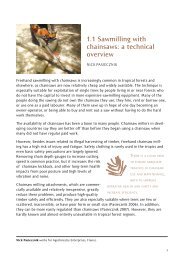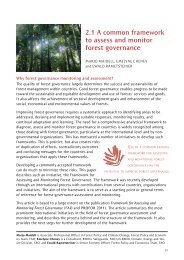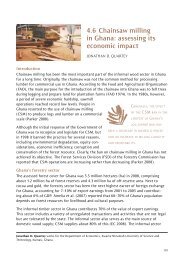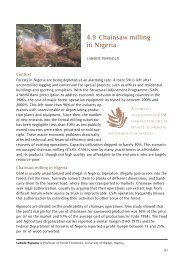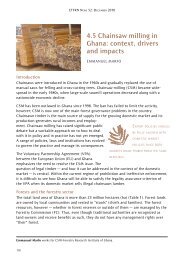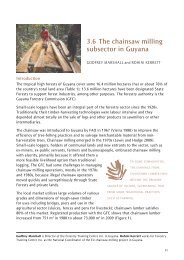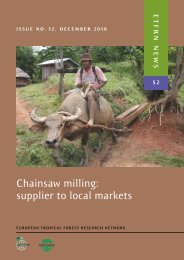Chainsaw milling: supplier to local markets - European Tropical ...
Chainsaw milling: supplier to local markets - European Tropical ...
Chainsaw milling: supplier to local markets - European Tropical ...
Create successful ePaper yourself
Turn your PDF publications into a flip-book with our unique Google optimized e-Paper software.
3.6 ThE chaiNsaw milliNg subsEcToR iN guyaNa<br />
To carry out chainsaw <strong>milling</strong>, a logger or sla requires an sFp and a sawpit licence; the<br />
sFp grants permission <strong>to</strong> fell a specified number of trees while the sawpit licence grants<br />
permission <strong>to</strong> “rip” logs (i.e., saw them in the direction of the grain) at the stump site. (a<br />
sawmill licence is required for the use of portable sawmills.) The model and serial number<br />
of all chainsaws used in sFps must be registered with the GFC, whether or not the owner<br />
intends <strong>to</strong> carry out chainsaw <strong>milling</strong>.<br />
most sFps have been allocated in logged-over forests or in forested areas designated<br />
as conversion forests. Frequently, the number of merchantable trees does not meet the<br />
expectations of loggers, even though the GFC encourages them <strong>to</strong> assess the area before<br />
putting in their applications.<br />
GFC set up its social Development programme (sDp) in 2001, in recognition of the<br />
growing importance of chainsaw <strong>milling</strong> <strong>to</strong> the socio-economic development of rural<br />
communities. programme objectives are <strong>to</strong> ensure that forest-based communities utilize<br />
the forest resources allocated <strong>to</strong> them in a sustainable manner and that, whenever<br />
possible, members of the community benefit directly from their forest resources. The GFC,<br />
in line with the goals under the programme, supports the formation of slas, providing<br />
them with technical assistance <strong>to</strong> organize themselves and acquire the proper legal<br />
instruments. as of June 30, 2010, 42 slas were registered with the GFC, holding a <strong>to</strong>tal<br />
of 76 sFps in state forests; a few slas operate on communal (amerindian) lands.<br />
all loggers within a community are encouraged <strong>to</strong> join their <strong>local</strong> sla. slas have 20–90<br />
members and provide the following benefits <strong>to</strong> them:<br />
• collective negotiation on forest resources;<br />
• collective negotiation on and use of technical assistance, training projects and donor<br />
funds; and<br />
• a more organized approach <strong>to</strong> negotiating prices for the lumber they produce.<br />
The operation of associations is challenging, since some loggers have considerable assets<br />
and others relatively little. These are some of the typical issues associated with management<br />
of slas:<br />
• improper management of documents (e.g., removal permits and log tags) issued <strong>to</strong><br />
slas by the GFC;<br />
• improper management of revenues generated by the slas;<br />
• lack of understanding of how GFC determines the number of tags and permits issued<br />
<strong>to</strong> each sla;<br />
• perceptions about the role, experience and behaviour of forest officers; and<br />
• concerns over the fines applicable <strong>to</strong> offences under the Forests Act.<br />
Taxes are paid on timber harvested from state Forests, but not from private or communal<br />
lands.<br />
a major component of GFC’s moni<strong>to</strong>ring practices is the log tracking system introduced in<br />
2000. GFC assigns a two-part tag <strong>to</strong> every tree approved for harvesting: one part is placed<br />
on the stump of the felled tree, and the other is placed on the log, where it stays until the<br />
93



